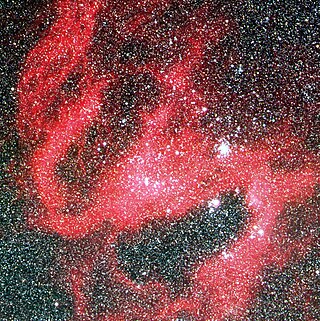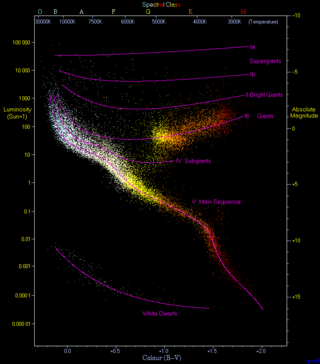
Apparent magnitude is a measure of the brightness of a star or other astronomical object observed from Earth. An object's apparent magnitude depends on its intrinsic luminosity, its distance from Earth, and any extinction of the object's light caused by interstellar dust along the line of sight to the observer.
Absolute magnitude is a measure of the luminosity of a celestial object on an inverse logarithmic astronomical magnitude scale. An object's absolute magnitude is defined to be equal to the apparent magnitude that the object would have if it were viewed from a distance of exactly 10 parsecs, without extinction of its light due to absorption by interstellar matter and cosmic dust. By hypothetically placing all objects at a standard reference distance from the observer, their luminosities can be directly compared among each other on a magnitude scale.

Vega is the brightest star in the northern constellation of Lyra. It has the Bayer designation α Lyrae, which is Latinised to Alpha Lyrae and abbreviated Alpha Lyr or α Lyr. This star is relatively close at only 25 light-years from the Sun, and one of the most luminous stars in the Sun's neighborhood. It is the fifth-brightest star in the night sky, and the second-brightest star in the northern celestial hemisphere, after Arcturus.

Luminosity is an absolute measure of radiated electromagnetic power (light), the radiant power emitted by a light-emitting object over time. In astronomy, luminosity is the total amount of electromagnetic energy emitted per unit of time by a star, galaxy, or other astronomical objects.

Supergiants are among the most massive and most luminous stars. Supergiant stars occupy the top region of the Hertzsprung–Russell diagram with absolute visual magnitudes between about −3 and −8. The temperature range of supergiant stars spans from about 3,400 K to over 20,000 K.

Zeta Puppis, formally named Naos, is a star in the constellation of Puppis.

The cosmic distance ladder is the succession of methods by which astronomers determine the distances to celestial objects. A direct distance measurement of an astronomical object is possible only for those objects that are "close enough" to Earth. The techniques for determining distances to more distant objects are all based on various measured correlations between methods that work at close distances and methods that work at larger distances. Several methods rely on a standard candle, which is an astronomical object that has a known luminosity.

S Doradus is one of the brightest stars in the Large Magellanic Cloud (LMC), a satellite galaxy of the Milky Way, located roughly 160,000 light-years away. The star is a luminous blue variable, and one of the most luminous stars known, having a luminosity varying widely above and below 1,000,000 times the luminosity of the Sun, although it is too far away to be seen with the naked eye.

In astronomy, magnitude is a unitless measure of the brightness of an object in a defined passband, often in the visible or infrared spectrum, but sometimes across all wavelengths. An imprecise but systematic determination of the magnitude of objects was introduced in ancient times by Hipparchus.

Xi Persei, known also as Menkib, is a star in the constellation of Perseus. Based upon parallax measurements taken during the Hipparcos mission, it is approximately 1,200 light-years from the Sun.

Gliese 667 is a triple-star system in the constellation Scorpius lying at a distance of about 7.2 parsecs from Earth. All three of the stars have masses smaller than the Sun. There is a 12th-magnitude star close to the other three, but it is not gravitationally bound to the system. To the naked eye, the system appears to be a single faint star of magnitude 5.89.
HD 196050 is a triple star system located in the southern constellation of Pavo. This system has an apparent magnitude of 7.50 and the absolute magnitude is 4.01. It is located at a distance of 112 light years from the Sun based on parallax, and is drifting further away with a radial velocity of +61 km/s. It is also called by the Hipparcos number 101806.

The Hertzsprung–Russell diagram, abbreviated as H–R diagram, HR diagram or HRD, is a scatter plot of stars showing the relationship between the stars' absolute magnitudes or luminosities versus their stellar classifications or effective temperatures. The diagram was created independently in 1911 by Ejnar Hertzsprung and by Henry Norris Russell in 1913, and represented a major step towards an understanding of stellar evolution.

Zeta1 Scorpii is a B-type hypergiant star in the constellation of Scorpius. It has an apparent visual magnitude which varies between 4.66 and 4.86. It is a member of the Scorpius OB1 association, and the open star cluster NGC 6231, also known as the "Northern jewel box" cluster. Around 36 times as massive as the Sun, it is also one of the most luminous stars known in the Galaxy, with an estimated bolometric luminosity of around 850,000 times that of the Sun and a radius 103 times that of the Sun.

Nu Eridani is a star in the constellation Eridanus. It is visible to the naked eye with an apparent visual magnitude of 3.93. The distance to this star is roughly 520 light years, based upon an annual parallax shift of 0.00625 arcseconds. If the star were 33 ly (10 pc) from the Sun, it would be the brightest star in the night sky with an apparent magnitude of −2.84.

30 Leonis Minoris is a single star in the northern constellation of Leo Minor. It is visible to the naked eye as a faint, white-hued point of light with an apparent visual magnitude of 4.72. The distance to this star, as estimated from parallax measurements, is 233 light years. It is drifting away from the Earth with a heliocentric radial velocity of +13.7 km/s.
Lambda Leporis, which is the Latinized form of λ Leporis, is a solitary, blue-white hued star in the southern constellation of Lepus. It is visible to the naked eye with an apparent visual magnitude of +4.29. Based upon an annual parallax shift of 3.83 mas, it is estimated to lie roughly 850 light years from the Sun. Relative to its neighbors, this star has a peculiar velocity of 16.3±2.8 km/s. It is a member of the Orion OB1 association, and it has been identified as a high-velocity runaway star.
In astronomy, the zero point in a photometric system is defined as the magnitude of an object that produces 1 count per second on the detector. The zero point is used to calibrate a system to the standard magnitude system, as the flux detected from stars will vary from detector to detector. Traditionally, Vega is used as the calibration star for the zero point magnitude in specific pass bands, although often, an average of multiple stars is used for higher accuracy. It is not often practical to find Vega in the sky to calibrate the detector, so for general purposes, any star may be used in the sky that has a known apparent magnitude.
HD 34255, also known HR 1720, is a star located in the northern circumpolar constellation Camelopardalis, the giraffe. It has an apparent magnitude of 5.60, allowing it to be faintly visible to the naked eye. The object is located relatively far at a distance of about 1.65 kly but is approaching the Solar System with a heliocentric radial velocity of −7.7 km/s.





















